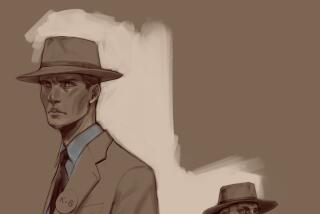BY DESIGN : Muckenthaler’s Man of Many Hats
- Share via
I f wherever you hang your hat is home, then the Muckenthaler Cultural Center in Fullerton must seem pretty welcoming these days. Give credit to exhibition administrator Robert Zingg, lately an artsy stand-in for the Mad Hatter.
His current exhibit, which runs through June 26, is on “Haute Hats.”
But these aren’t your average head ornaments or sun shades. The 32-year-old Zingg points out that hats have historically been used to connote wealth, religion, culture, nationality, rank, political belief or occupation. There are more than 50 of them displayed, from the turn of the century to the present.
The busy Zingg (he’s also curated shows on kites, Art Deco toys and kinetic sculpture for the Muckenthaler) says that “much like creating a hat, there’s a lot of behind-the-scenes work that goes into creating an exhibit.”
I never really paid much attention to hats until now because when I was growing up in the ‘60s and ‘70s, there weren’t too many that stood out, except Jackie Kennedy’s pillbox, which became a cultural icon like Charlie Chaplin’s bowler.
As a kid, I was too young to watch Fess Parker play “Davy Crockett” on TV in the ‘60s, so I never wanted one of those coonskin hats. And when I was older, it was the Farrah-hair era, and everyone wore lots of hair instead of hats.
Before, I would only wear baseball caps on a bad hair day, but after seeing this exhibit, I want a Panama-style hat made of tightly woven, beautifully finished straw from the ‘40s, like the one we have in the show.
The hats come from private collections, the Costume and Textile Guild of North Orange County and Louise Green Millinery of Santa Monica. There are also some from contemporary artists Sayra Adams and Lyric Watson, who make them by hand and one at a time.
In doing my research I found, surprisingly, that there isn’t a lot written about hats. Much like an archeological dig, the Costume and Textile Guild searches through old Sears catalogues to find information on the styles popular at the time.
We also found that the “theater rule” started in 1907, which forced woman to take their picture hats off during a performance, and the National Audubon Society came into existence in 1905 because the bird population was being decimated by the millinery trade.
Not only did ladies want aigrettes placed on their hats but the whole egret bird. Aigrette substitutes like dyed goose and chicken feathers were used afterward. Other hat trimmings over the years include fruits, flowers, leaves, veils, grosgrain, ball fringe, beads, tiny mirrors, bangles, fur, tweed, lace and pompons.
Before I produced this exhibit, I thought all it took to make a hat was a hat body and somebody to put some stuff on it. Now I know the difference between the crown, brim, band, sweatband and trimmings and how the hat design reflects other trends in fashion at the time.
We tried to make the exhibit educational as well as visual. Rather than just show a finished hat, we use photomurals to show the process and the raw materials used to make it. We have different hat bodies made of straw, velour, felt, velvet and rolled paper, called toyo.
And we have a glossary of names. Most of them are French--like chapeau (hat) or cloche (a tight-fitting one pulled over the forehead)--because at the beginning of the century, Paris was the hat mecca.






